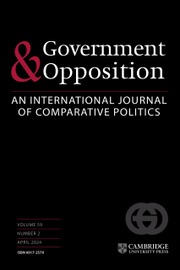Crossref Citations
This article has been cited by the following publications. This list is generated based on data provided by
Crossref.
Fossati, Diego
and
Martinez i Coma, Ferran
2020.
Exploring citizen turnout and invalid voting in Indonesia: two sides of the same coin?.
Contemporary Politics,
Vol. 26,
Issue. 2,
p.
125.
Lysek, Jakub
Lebeda, Tomáš
and
Kouba, Karel
2020.
Turning out but not voting: invalid ballots in post-communist parliamentary elections.
Comparative European Politics,
Vol. 18,
Issue. 2,
p.
190.
Bali, Valentina A.
Robison, Lindon J.
and
Winder, Richard
2020.
What Motivates People to Vote? The Role of Selfishness, Duty, and Social Motives When Voting.
Sage Open,
Vol. 10,
Issue. 4,
Nyhuis, Dominic
2021.
Bequem, aber fehleranfällig: Die Dunkelziffer ungewerteter Briefwahlstimmen.
Politische Vierteljahresschrift,
Vol. 62,
Issue. 4,
p.
597.
Haman, Michael
2021.
Recall Elections: A Tool of Accountability? Evidence from Peru.
Desarrollo y Sociedad,
p.
73.
Kroeber, Corinna
Le Gall, Cal
and
Dingler, Sarah C.
2021.
How individuals’ social characteristics impact the likelihood to waste a vote – evidence from Great Britain, Germany and France.
Journal of Elections, Public Opinion and Parties,
Vol. 31,
Issue. 3,
p.
388.
Kouba, Karel
2021.
Where is the class bias attenuation? The consequences of adopting compulsory voting in Austria-Hungary in 1907.
European Political Science Review,
Vol. 13,
Issue. 2,
p.
151.
Lundell, Krister
and
Högström, John
2021.
Institutions or the Societal Setting? Explaining Invalid Voting in Local Elections in Sweden.
Scandinavian Political Studies,
Vol. 44,
Issue. 3,
p.
280.
Haman, Michael
and
Haman, Michael
2021.
Invalid votes under compulsory voting: Poverty and runoff voting in Peruvian municipalities.
ACTA POLITOLOGICA,
Vol. 13,
Issue. 1,
p.
1.
Lysek, Jakub
Pánek, Jiří
and
Lebeda, Tomáš
2021.
Who are the voters and where are they? Using spatial statistics to analyse voting patterns in the parliamentary elections of the Czech Republic.
Journal of Maps,
Vol. 17,
Issue. 1,
p.
33.
Holloway, Josh
and
Miragliotta, Narelle
2021.
Examining the Effects of Convenience Voting on Accidental Invalidity.
Election Law Journal: Rules, Politics, and Policy,
Vol. 20,
Issue. 3,
p.
272.
Harka, Elona
and
Rocco, Lorenzo
2022.
Studying more to vote less. Education and voter turnout in Italy.
European Journal of Political Economy,
Vol. 72,
Issue. ,
p.
102115.
Schwuchow, Soeren C.
and
Tridimas, George
2022.
The political economy of Solon’s law against neutrality in civil wars.
Public Choice,
Vol. 192,
Issue. 3-4,
p.
249.
Adeleke, Richard
Alabede, Opeyemi
and
Amusan, Kehinde
2022.
Geospatial Analysis of Invalid Voting in the 2019 Presidential Election in Nigeria.
Journal of Geovisualization and Spatial Analysis,
Vol. 6,
Issue. 2,
Silva, Patrick Cunha
and
Crisp, Brian F
2022.
Ballot spoilage as a response to limitations on choice and influence.
Party Politics,
Vol. 28,
Issue. 3,
p.
521.
Camatarri, Stefano
2022.
What if it Kicked in More Strongly? A Counterfactual Analysis of Protest Voting's Electoral Consequences in Greece, Italy and Spain.
Representation,
Vol. 58,
Issue. 1,
p.
103.
PLESCIA, CAROLINA
KRITZINGER, SYLVIA
and
SINGH, SHANE P.
2023.
Who would vote NOTA? Explaining a ‘none of the above’ choice in eight countries.
European Journal of Political Research,
Vol. 62,
Issue. 1,
p.
118.
Subekti, Dimas
Sutan, Arissy Jorgy
Nurmandi, Achmad
Mutiarin, Dyah
and
Al-Hamdi, Ridho
2023.
The protest voting behaviour among local voters in the 2020 Surakarta mayoral election.
Asian Journal of Comparative Politics,
Vol. 8,
Issue. 4,
p.
840.
Kouba, Karel
and
Dosek, Tomas
2023.
Democratizing urban governance through mayoral term limits: Quasi-experimental evidence from a reform in Chilean municipalities.
Cities,
Vol. 140,
Issue. ,
p.
104446.
Nyhuis, Dominic
Harmening, Morten
and
Swalve, Tilko
2024.
Wie institutionelle Hürden die soziale Selektivität der Wahl verschärfen: Das Beispiel von Formfehlern bei der Briefwahl.
Swiss Political Science Review,
Vol. 30,
Issue. 3,
p.
309.

